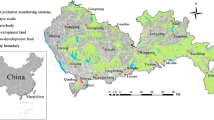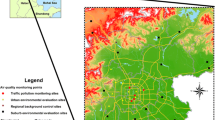Abstract
Understanding the spatial distribution of PM2.5 concentration and its contributing environmental variables is critical to develop strategies of addressing adverse effects of the particulate pollution. In this study, a range of meteorological and land use factors were incorporated into a linear regression (LR) model and a logistic model-based regression (LMR) model to simulate the annual and winter PM2.5 concentrations. The vegetation cover, derived from a linear spectral unmixing analysis (LSUA), and the normalized difference built-up index (NDBI), were found to improve the goodness of fit of the models. The study shows that (1) both the LR and the LMR agree on the predicted spatial patterns of PM2.5 concentration and (2) the goodness of fit is higher for the models established based on the annual PM2.5 concentration than that based on the winter PM2.5. The modeling results show that higher PM2.5 concentration coincided with the major urban area for the annual average but focused on the suburban and rural areas for the winter. The methods introduced in this study can potentially be applied to similar regions in other developing countries.





Similar content being viewed by others
References
Akimoto, H. (2003). Global air quality and pollution. Science, 302, 1716–1719.
Atkinson, R. W., Anderson, H. R., Sunyer, J., Ayres, J. G., & Michela, B. (2001). Acute effects of particulate air pollution on respiratory admissions. American Journal of Respiratory and Critical Care Medicine, 164, 1860–1866.
Beckerman, B. S., Jerrett, M., Serre, M., Martin, R. V., Lee, S. J., Van, D. A., & Burnett, R. T. (2013). A hybrid approach to estimating national scale spatiotemporal variability of PM2.5 in the contiguous United States. Environmental Science & Technology, 47(13), 7233–7241.
Beckett, K. P., FreerSmith, P. H., & Taylor, G. (2000). Particulate pollution capture by urban trees: effect of species and windspeed. Global Change Biology, 6(8), 995–1003.
Bian, H., Tie, X., Cao, J., Ying, Z., Han, S., & Xue, Y. (2011). Analysis of a severe dust storm event over China: application of the WRF-dust model. Aerosol and Air Quality Research, 11(4), 419–428.
Cao, J., Shen, Z., Chow, J., Watson, J. G., Lee, S., Tie, X., & Han, Y. (2012). Winter and summer PM2.5 chemical compositions in fourteen Chinese cities. Journal of the Air & Waste Management Association, 62(10), 1214–1226.
Chaloulakou, A., Kassomenos, P., Spyrellis, N., Demokritou, P., & Koutrakis, P. (2003). Measurements of PM10 and PM2.5 particle concentrations in Athens, Greece. Atmospheric Environment, 37(5), 649–660.
Chen, X., Zhao, H., Li, P., & Yin, Z. (2006). Remote sensing image-based analysis of the relationship between urban heat island and land use/cover changes. Remote Sensing of Environment, 104(2), 133–146.
Cheng, Y., & Li, Y. (2010). Influences of traffic emissions and meteorological conditions on ambient PM10 and PM2.5 levels at a highway toll station. Aerosol and Air Quality Research, 10, 456–462.
Cotrufo, M. F., De, S. Z. V., Alfani, A., Bartoli, G., & De, C. A. (1995). Effects of urban heavy metal pollution on organic matter decomposition in Quercus ilex L. woods. Environmental Pollution, 89(1), 81–87.
Farmer, A. (1995). Reducing the impact of air pollution on the natural environment. Joint Nature Conservation Committee pp 112.
Feng, J., Hu, J., Xu, B., Hu, X., Sun, P., Han, W., Gu, Z., Yu, X., & Wu, M. (2015). Characteristics and seasonal variation of organic matter in PM2.5 at a regional background site of the Yangtze River Delta region, China. Atmospheric Environment, 123, 288–297.
Giugliano, M., Lonati, G., Butelli, P., Romele, L., Tardivo, R., & Grosso, M. (2005). Fine particulate (PM2.5-PM1) at urban sites with different traffic exposure. Atmospheric Environment, 39(13), 2421–2431.
Glavas, S. D., Nikolakis, P., Ambatzoglou, D., & Mihalopoulos, N. (2008). Factors affecting the seasonal variation of mass and ionic composition of PM2.5 at a central Mediterranean coastal site. Atmospheric Environment, 42(21), 5365–5373.
Green, A. A., Berman, M., Switzer, P., & Craig, M. D. (1988). A transformation for ordering multispectral data in terms of image quality with implications for noise removal. Geoscience and Remote Sensing, IEEE Transaction, 26(1), 65–74.
Grossman, G. M., & Krueger, A. B. (1994). Economic growth and the environment (No. w4634). National Bureau of Economic Research, doi: 10.1057/9780230226203.1158.
Hu, X., Zhang, Y., Ding, Z., Wang, T., Lian, H., Sun, Y., & Wu, J. (2012). Bioaccessibility and health risk of arsenic and heavy metals (Cd, Co, Cr, Cu, Ni, Pb, Zn and Mn) in TSP and PM2.5 in Nanjing, China. Atmospheric Environment, 57, 146–152.
Jensen, J. R., & Cowen, D. C. (1999). Remote sensing of urban/suburban infrastructure and socio-economic attributes. Photogrammetric Engineering and Remote Sensing, 65, 611–622.
Kloog, I., Nordio, F., Coull, B. A., & Schwartz, J. (2012). Incorporating local land use regression and satellite aerosol optical depth in a hybrid model of spatiotemporal PM2.5 exposures in the Mid-Atlantic states. Environmental Science & Technology, 46(21), 11913–11921.
Liu, Y., Paciorek, C. J., & Koutrakis, P. (2009). Estimating regional spatial and temporal variability of PM2.5 concentrations using satellite data, meteorology, and land use information. Environmental Health Perspectives, 117(6), 886.
Lu, D., & Weng, Q. (2006). Spectral mixture analysis of ASTER images for examining the relationship between urban thermal features and biophysical descriptors in Indianapolis, Indiana, USA. Remote Sensing of Environment, 104(2), 157–167.
Lu, D., Moran, E., & Batistella, M. (2003). Linear mixture model applied to Amazonian vegetation classification. Remote Sensing of Environment, 87(4), 456–469.
Marcazzan, G. M., Vaccaro, S., Valli, G., & Vecchi, R. (2001). Characterisation of PM10 and PM2.5 particulate matter in the ambient air of Milan (Italy). Atmospheric Environment, 35(27), 4639–4650.
Pope III, C. A., Burnett, R. T., Thun, M. J., Calle, E. E., Krewski, D., Ito, K., & Thurston, G. D. (2002). Lung cancer, cardiopulmonary mortality, and long-term exposure to fine particulate air pollution. JAMA, 287(9), 1132–1141.
Querol, X., Alastuey, A., Viana, M. M., Rodriguez, S., Artíñano, B., Salvador, P., De, L., & Campa, A. S. (2004). Speciation and origin of PM10 and PM2.5 in Spain. Journal of Aerosol Science, 35(9), 1151–1172.
Rodriguez, S., Querol, X., Alastuey, A., Viana, M. M., Alarcon, M., Mantilla, E., & Ruiz, C. R. (2004). Comparative PM10-PM2.5 source contribution study at rural, urban and industrial sites during PM episodes in Eastern Spain. Science of the Total Environment, 328(1), 95–113.
Scott, K. I., McPherson, E. G., & Simpson, J. R. (1998). Air pollutant uptake by Sacramento’s urban forest. Journal of Arboriculture, 24, 224–234.
Sparks, J. P., Monson, R. K., Sparks, K. L., & Lerdau, M. (2001). Leaf uptake of nitrogen dioxide (NO2) in a tropical wet forest: implications for tropospheric chemistry. Oecologia, 127(2), 214–221.
Sun, Y., Zhuang, G., Tang, A., Wang, Y., & An, Z. (2006). Chemical characteristics of PM2.5 and PM10 in haze-fog episodes in Beijing. Environmental Science & Technology, 40(10), 3148–3155.
Sun, H., Qie, G., Wang, G., Tan, Y., Li, J., Peng, Y., & Luo, C. (2015). Increasing the accuracy of mapping urban forest carbon density by combining spatial modeling and spectral unmixing analysis. Remote Sensing, 7(11), 15114–15139.
Tallis, M., Taylor, G., Sinnett, D., & Freer-Smith, P. (2011). Estimating the removal of atmospheric particulate pollution by the urban tree canopy of London, under current and future environments. Landscape and Urban Planning, 103(2), 129–138.
Theseira, M. A., Thomas, G., & Sannier, C. A. D. (2002). An evaluation of spectral mixture modelling applied to a semi-arid environment. International Journal of Remote Sensing, 23(4), 687–700.
Tiwari, S., Chate, D. M., Pragya, P., Ali, K., & Bisht, D. S. (2012). Variations in mass of the PM10, PM2.5 and PM1 during the monsoon and the winter at New Delhi. Aerosol and Air Quality Research, 12(1), 20–29.
Wallace, L. (2000). Correlations of personal exposure to particles with outdoor air measurements: a review of recent studies. Aerosol Science & Technology, 32(1), 15–25.
Wang, S., Li, G., Gong, Z., Du, L., Zhou, Q., Meng, X., Xie, S., & Zhou, L. (2015). Spatial distribution, seasonal variation and regionalization of PM2.5 concentrations in China. Science China: Chemistry, 58(9), 1435–1443.
Wang, F., Guo, Z., Lin, T., & Rose, N. L. (2016). Seasonal variation of carbonaceous pollutants in PM2.5 at an urban ‘supersite’ in Shanghai, China. Chemosphere, 146, 238–244.
Wei, F., Teng, E., Wu, G., Hu, W., Wilson, W. E., Chapman, R. S., Pau, J. C., & Zhang, J. (1999). Ambient concentrations and elemental compositions of PM10 and PM2.5 in four Chinese cities. Environ. Sci. Technology, 33(23), 4188–4193.
Wiedinmyer, C., Steiner, A., & Ashworth, K. (2013). Plant influences on atmospheric chemistry. The plant sciences. Ecology and the environment. New York: Springer.
Wu, C. (2004). Normalized spectral mixture analysis for monitoring urban composition using ETM+ imagery. Remote Sensing of Environment, 93(4), 480–492.
Wu, C., & Murray, A. T. (2003). Estimating impervious surface distribution by spectral mixture analysis. Remote Sensing of Environment, 84(4), 493–505.
Xiao, Q., Ma, Z., Li, S., & Liu, Y. (2015). The impact of winter heating on air pollution in China. PloS One, 10(1), e0117311. doi:10.1371/journal.pone.0117311.
Xiong, Y., Huang, S., Chen, F., Ye, H., Wang, C., & Zhu, C. (2012). The impacts of rapid urbanization on the thermal environment: a remote sensing study of Guangzhou, South China. Remote Sensing, 4(7), 2033–2056.
Yang, J., McBride, J., Zhou, J., & Sun, Z. (2005). The urban forest in Beijing and its role in air pollution reduction. Urban Forestry & Urban Greening, 3(2), 65–78.
Zha, Y., Gao, J., & Ni, S. (2003). Use of normalized difference built-up index in automatically mapping urban areas from TM imagery. International Journal of Remote Sensing, 24(3), 583–594.
Zhang, R., Xu, F., & Han, Z. (2003). Inorganic chemical composition and source signature of PM2.5 in Beijing during ACE-Asia period. Chinese Science Bulletin, 48(10), 1002–1005.
Acknowledgements
We appreciate the constructive comments from anonymous reviewers that contribute to the improvement of this paper. This study was supported by the research project “Remote sensing technology for studying urban haze pollution” awarded by the Zhejiang Province Science and Technology Public Welfare Project (2013C33027) and Zhejiang Province Science and Technology Project (LY12D01003), Zhejiang A & F University.
Author information
Authors and Affiliations
Corresponding authors
Rights and permissions
About this article
Cite this article
Xiang, J., Li, R., Wang, G. et al. Modeling Urban PM2.5 Concentration by Combining Regression Models and Spectral Unmixing Analysis in a Region of East China. Water Air Soil Pollut 228, 250 (2017). https://doi.org/10.1007/s11270-017-3421-6
Received:
Accepted:
Published:
DOI: https://doi.org/10.1007/s11270-017-3421-6




